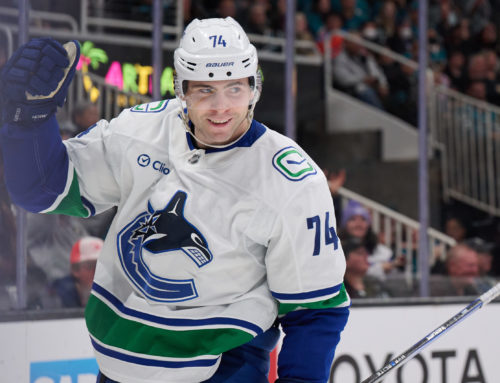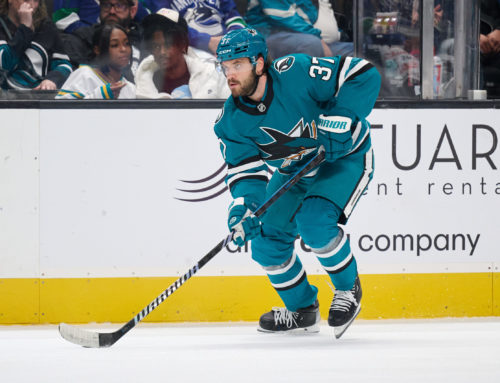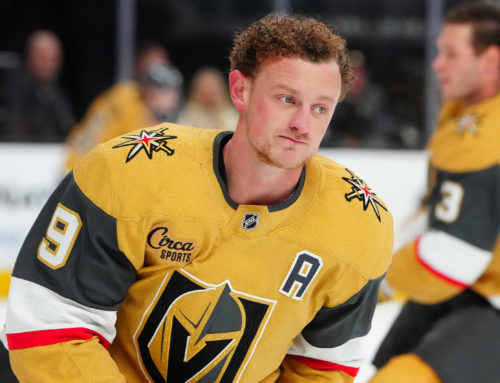The Best in the West: Defensemen (2016-17)
Doran Libin
2016-08-01

Running down the top 10 fantasy hockey defensemen from the Western Conference.
The best defensemen in the West may as well be a list of the top power play quarterbacks on each team. The only defenseman to even warrant consideration for this list that did not receive consistent top power play minutes was TJ Brodie. Fewer than 50 defensemen averaged more than a point per 60 minutes at even strength last year. Conversely nearly 40 defensemen averaged more than three points per 60 minutes on the power play. That means that the ceiling on even strength is low enough that a defenseman who receives top unit power play minutes can more than make up for subpar even strength production with his power play points. There are two examples on this list of defensemen who did just that. Most top power play unit defensemen will receive in excess of 120 extra minutes on the power play, basically good for eight to 15 extra points. Conversely a defenseman who scores 1.3 points per minute at even strength, top five in the league amongst defensemen with more than 200 minutes at even strength, only gave a six-point advantage on a defenseman who finishes 50th. Not that anyone reading this was unaware of the importance of power play production for defensemen.
Honourable Mentions:
TJ Brodie missed the top 10 because since Hamilton’s arrival he does not get the opportunities on the power play that he did previously. Last year’s 45 points were based on him being involved in over 45% of the Flames goals scored when he was on the ice, he assisted on 40% of them. That is simply not a sustainable rate.
Duncan Keith missed the list because of the drop in the Blackhawks’ even strength scoring. Keith had 18 power-play points last year but only 25 points at even strength. The arrival of Brian Campbell should help the Blackhawks’ even strength scoring but it may push Keith into a more defensive role.
Dougie Hamilton had a very productive year even after producing only five points in his first 25 games. Hamilton’s power play time went up as the season progressed but he has far from proven that he is capable of out producing Doughty, Keith and Shattenkirk.
10. Drew Doughty
As the Kings continue to lose core players Doughty becomes increasingly important to their every aspect of their game. In each of the last two years Doughty has played more than 28 minutes per game, with that extreme usage Doughty does not need to produce at the same per 60-minute rate that other defensemen must achieve. Which is very good for Doughty as he plays a ton of minutes in situations that are not especially conducive to him producing points. It also does not help Doughty that the Kings are a low event and are 16th in the league in goals for per 60 minutes. For fantasy purposes Doughty would be better served by getting the type of offense-centric usage that Shattenkirk and Tyson Barrie receive but he is far too valuable at both ends of the ice for that to be realistic. Thus while he is a top five, arguably top three, defenseman in the NHL for fantasy purposes he is closer to top twenty.
9. Tyson Barrie
Barrie has shown himself to be one of the best offensive defensive in the game. Barrie has improved his points per 60 on the power play in each of the last three years, hitting five points per 60 last year. Only 10 other defensemen hit the five points per 60 minute on the power play which puts Barrie in some pretty impressive company. It is slightly worrisome that Barrie’s even strength production rate has fallen off so much as after two seasons at above a point per 60 minutes at even strength he fell to 0.9 points per 60 minutes and almost out of the top 50 in defensemen in the league. That puts a lot of stress on his ability to maintain an elite production rate on the power play as power play points accounted for 40% of his production last season. Barrie will not be able to hit 50 points again if he does turn this trend around. It looks to be largely due to a falling assist rate as he went from assisting on over 30% of the goals scored at even strength when he is on the ice to 20%. This can also be seen in his falling expected goals per 60 minutes at even strength. This is a bet on his ability to buck the trend.
8. Mark Giordano
As Giordano finally played a full season he also cracked 50 points for the first time. Even as the Flames team shooting percentage dropped from the heights of 2014/15 Giordano was able to adapt his game to continue producing points. It is more like his offensive game went back to where it was in 2013/14 as he scored 15% of the Flames’ goals when he was on the ice and assisted on 30% of them. Where Giordano’s point totals may get a bump is on the power play where the addition of Troy Brouwer gives the Flames a very capable net front presence. Brouwer consistently produces at least four points per 60 minutes on the power play and will give the Flames a consistent fifth man on the power play, something they did not have last season.
7. Kevin Shattenkirk
It was tempting to put Shattenkirk higher on the list last year but his power play production seemed to be unsustainable, then he went on basically duplicated it last year, but his even strength scoring fell to its lowest rate in three years. That was based off an unusually low assist rate on the goals scored while he was on the ice at even strength, about half his career rate. The low assist rate looks to be due to the Blues scoring on only 6.6% of their shots with Shattenkirk on the ice at even strength. Given that the Blues had their lowest expected goals per 60 rate, and shots per 60 rate, in three years with Shattenkirk the low shooting percentage is somewhat expected but this is likely a one-year blip and Shattenkirk should get over 50 points again this year.
6. Oliver Ekman-Larsson
The arrival of Alex Goligoski could actually hurt Ekman-Larsson (OEL) as it gives the Coyotes a second legitimate option to quarterback the power play. While OEL will not lose his spot on the top unit, he could lose some of the abundance of minutes that he saw last year. A slight decrease in power play minutes will not drastically hurt OEL’s value as he averaged more than five minutes per game as his minutes were re-distributed to focus on offense. The Coyotes lost no one of significance on the blue line, with Nick Grossmann’s minutes being replaced with Luke Schenn, and as such OEL should continue to get an abundant of offensive minutes. If anything OEL could get another boost in his scoring if the Coyotes introduce some of their young forward talent (e.g. Christian Dvorak and Dylan Strome) into the lineup this season. An added bonus to owning OEL is his burgeoning multi-category game as he played with a more pronounced edge last year with 96 penalty minutes to complement his 150 hits and 70 blocks.
5. Dustin Byfuglien
Over the last three seasons Byfuglien has averaged just over three shots per game and 0.65 points per game. Were it not for him missing 13 games in 2014/15 he would be coming off of three consecutive 50+ point seasons. With the Jets adding Patrik Laine and the emergence of Mark Scheifele as a true number-one center down the stretch last year there is the potential that the Jets offense could be even better. Byfuglien is routinely involved in over 40% of the Jets’ goals because of how he drives, and jumps into the play. If that was all Byfuglien did he would be deserving of a spot on this list, however, he also provides value in peripheral categories as he has had over 100 penalty minutes and 200 hits in each of the last two seasons along with a block per game. He is the definition of a multi-category stud, producing value in basically every category.
4. PK Subban
Someone is going to need to get the power-play goals that Shea Weber provided for the Predators and the obvious choice looks to be the guy directly replacing him. Subban has already shown the ability to put up some big goal totals but the Montreal power play did not give him the same type of opportunities that the Nashville power play afforded Weber. With both players possessing an elite shot it would seem natural that Subban would have some semblance of the success that Weber enjoyed on the Nashville power play. A 20-goal/60-point season is not out of the question for Subban.
3. Roman Josi
The departure of Shea Weber could hurt Roman Josi offensively if he has to stop jumping into the play offensively because he no longer has a partner back on defense to cover for him. It should not, however, affect him on the power play where PK Subban is more than capable of filling Weber’s shoes in that role. If anything it replacing Weber with Subban should help Josi as it provides another mobile option capable of creating space for others on the ice. Expect a minor learning curve period at the beginning of the season as Josi gets used to a new partner but Josi remains one of the premier offensive defensemen in the league.
2. John Klingberg
When the Stars were on fire at the beginning of last Klingberg was keeping up with Erik Karlsson producing over a point per game. While Karlsson was able to sustain that pace for the full year, Klingberg fell off the pace significantly. It did not help that Tyler Seguin missed most of March and all of April, hurting the Stars power play. In his third year look for less peaks and valleys in Klingbergs game as the Stars will rely on him more than ever after losing Alex Goligoski and Jason Demers to free agency. With no great second power play option left on the defense corps Klingberg could be looking at the type of power play usage that OEL received last year.
1. Brent Burns
Brent Burns place atop this list is due entirely to his absurd shot rate, namely 4.3 shots per game. Last year that was good for 100 more shots than the defenseman with the second most shots. During the Stanley Cup Final the Penguins were forcing Burns to shoot from the outside and were blocking a lot of his shots, which is problematic if other teams can replicate their success this year. That being said it is much easier to game plan for a specific player when a team only has to worry about one opponent for the rest of the season. Burns ranking is a bet that his shot rate was not an abnormality but a sign of things to come.
I have been negligent in doing this so credit for the statistics that appear in this column goes to: Corsica.hockey,, stats.hockeyanalysis.com, hockey-reference.com, and puckalytics.com, as well as war-on-ice.com when it was still up and running.





 PIT
PIT WPG
WPG ANA
ANA BUF
BUF DAL
DAL CBJ
CBJ S.J
S.J COL
COL CGY
CGY CAR
CAR DET
DET
